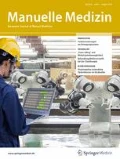Zusammenfassung
Die erlernte Nasenatmung unterliegt vielfältigen Einflüssen. Beeinträchtigungen durch Obstruktionen führen zum einen zu einer morphologisch-anatomischen Beeinflussung im Wachstum des Gesichtsschädels und des stomatognathen Systems. Darüber hinaus hat eine dauerhaft atypische Zungenlage auch negative Auswirkungen auf die sprachliche Entwicklung. Zum anderen ergeben sich durch die unterschiedliche Sättigung der Atemluft mit Kohlenstoffdioxid in der nasalen und oralen Luftpassage direkte Einflüsse auf den pH-Wert und die Sauerstoffversorgung auf alveolärer Ebene (Bohr-Effekt). Diese Prozesse wirken sich auf die Ventilation aus. Sie sind gehäuft mit internistischen Erkrankungen verbunden. Aus diagnostischer und therapeutischer Sicht sollte frühzeitig auf eine funktionierende Nasenluftpassage geachtet und störende Einflüsse sollten eher frühzeitig als zu lange abwartend therapiert werden.
Abstract
Learned nasal breathing is subject to many different influences. Obstructions can lead to morphologic and anatomic changes in growth of the facial skull and the stomatognathic system. Moreover, a permanently atypical position of the tongue also has a negative influence on speech development. On the other hand, the differential saturation of inspired air with carbon dioxide in the nasal and oral airways directly influences pH and oxygen saturation at the alveolar level (Bohr effect). These circumstances influence ventilation and are frequently associated with internal diseases. From the diagnostic and therapeutic perspective, attention should be paid to functional nasal breathing, and pathologic conditions should be eliminated early rather than observing for too long.


Abbreviations
- CO2 :
-
Kohlenstoffdioxid
- EKG:
-
Elektrokardiogramm
- HNO-:
-
Hals-Nasen-Ohren-
- min:
-
Minute
- NO:
-
Stickstoffmonoxid
Literatur
Azuma Y, Maehara K, Tokunaga T, Hashimoto M, Ieoka K, Sakagami H (1999) Systemic effects of the occlusal destruction in guinea pigs. In Vivo 13(6):519–524
Bauer M (1997) Stickstoffmonoxid. Anaesthesist 46:441–450. https://doi.org/10.1007/s001010050424
Borrie FRP, Bearn DR, Innes NPT et al (2015) Interventions for the cessation of non-nutritive sucking habits in children. Cochrane Database Syst Rev 3:CD8694. https://doi.org/10.1002/14651858.CD008694.pub2
Chen X (2015) Effects of breast-feeding duration, bottle-feeding duration and non-nutritive sucking habits on the occlusal characteristics of primary dentition. BMC Pediatr 15:46
Courtney R, Cohen M (2008) Investigating the claims of Konstantin Buteyko, M.D., Ph.D.: the relationship of breath holding time to end tidal CO2 and other proposed measures of dysfunctional breathing. J Altern Complement Med 14(2):115–123
D’Attilio M, Filippi MR, Femminella B, Festa F, Tecco S (2005) The influence of an experimentally-induced malocclusion on vertebral alignment in rats: a controlled pilot study. Cranio 23(2):119–129. https://doi.org/10.1179/crn.2005.017
Dimopoulou I, Tsintzas OK, Alivizatos PA, Tzelepis GE (2001) Pattern of breathing during progressive exercise in chronic heart failure. Int J Cardiol 81(2–3):117–121. https://doi.org/10.1016/s0167-5273(01)00562-9 (discussion 121–2)
Dixit U, Shetty R (2013) Comparison of soft-tissue, dental, and skeletal characteristics in children with and without tongue thrusting habit. Contemp Clin Dent 4(1):2–6
Einspieler C, Marschik PB (2012) Central Pattern Generators und ihre Bedeutung für die foetale Motorik. Klin Neurophysiol 43:16–21
Fanfulla F, Mortara A, Maestri R, Pinna GD, Bruschi C, Cobelli F, Rampulla C (1998) The development of hyperventilation in patients with chronic heart failure and Cheyne-Strokes respiration: a possible role of chronic hypoxia. Chest 114(4):1083–1090. https://doi.org/10.1378/chest.114.4.1083
Hinton RJ (1988) Response of the intermaxillary suture cartilage to alterations in masticatory function. Anat Rec 220(4):376–387
ELF (2012) Ihre Lunge und sportliche Aktivitäten. https://www.europeanlung.org/assets/files/de/publications/lungs-and-exercise-de.pdf. Zugegriffen: 27.10.2020
Spektrum (1999) Bohr-Effekt. https://www.spektrum.de/lexikon/biologie/bohr-effekt/9928. Zugegriffen: 27.10.2020
Johnson BD, Beck KC, Olson LJ, O’Malley KA, Allison TG, Squires RW, Gau GT (2000) Ventilatory constraints during exercise in patients with chronic heart failure. Chest 117(2):321–332. https://doi.org/10.1378/chest.117.2.321
Korbmacher H, Eggers-Ströder G, Koch L, Kahl-Nieke B (2004) Correlations between anomalies of the dentition and pathologies of the locomotor system—a literature review. J Orofac Orthop 65:190–203
Korbmacher H, Giel B (2007) Artikulationsstörungen in Wechselwirkung mit dem orofazialen Komplex. Handbuch der Pädagogik und Psychologie bei Behinderungen, Bd. 1. Hofgrefe, Göttingen
Korbmacher-Steiner H (2019) Kieferorthopädie und Funktion. https://www.zm-online.de/archiv/2019/01_02/zahnmedizin/kieferorthopaedie-und-funktion/. Zugegriffen: 27.10.2020
Moss ML (1968) A theoretical analysis of the functional matrix. Acta Biotheor 18(1):195–202
Nishi S, Basri R, Rahman N, Husein A, Alam M (2015) Association between muscle activity and overjet in class II malocclusion with surface electromyography. J Orthod Sci 7:3
Shimomoto Y, Chung CJ, Iwasaki-Hayashi Y, Muramoto T, Soma K (2007) Effects of occlusal stimuli on alveolar/jaw bone formation. J Dent Res 86(1):47–51
Gameiro GH, Magalhães IB, Szymanski MM et al (2017) Is the main goal of mastication achieved after orthodontic treatment? A prospective longitudinal study. Dental Press J Orthod 22(3):72–78. https://doi.org/10.1590/2177-6709.22.3.072-078.oar
Rakhimov A (2018) Mund- oder Nasenatmung? Warum durch die Nase geatmet werden soll für mehr Sauerstoff und Gesundheit. https://www.atmung.org/mundatmung-vs-nasenatmung/. Zugegriffen: 27.10.2020
Roux W (1902) Über die Selbstregulation der Lebewesen. Archiv für Entwicklungsmechanik der Organismen Bd. VIII. Wilhelm Engelmann, Leipzig
Sacher R, Süggeler O (2012) Der Kreuzbiss im Milchgebiss. Manuelle Medizin 50:50–54
Siegler R, DeLoache J, Eisenberg N (2005) Entwicklungspsychologie im Kindes- und Jugendalter. Spektrum Akademischer Verlag, Heidelberg (Kapitel 3: Biologie und Verhalten)
Sieron HL, Sommer F, Hoffmann TK et al (2020) Funktion und Physiologie der Kieferhöhle. HNO 68:566–572. https://doi.org/10.1007/s00106-020-00869-2
Solow B, Kreiborg S (1977) Weichteildehnung: Ein möglicher Kontrollfaktor in der kraniofazialen Morphogenese. Scand J Dent Res 85(6):505–57. https://doi.org/10.1111/j.1600-0722.1977.tb00587.x
Sullivan LH (1896) The tall office building artistically considered
Tanaka Y, Morikawa T, Honda Y (1988) An assessment for nasal functions in control of breathing https://doi.org/10.1152/jappl.1988.65.4.1520.öp
Wolff J (1884) Das Gesetz der Transformation der inneren Architektur der Knochen bei pathologischer Veränderung der äusseren Knochenform. Sitzungsbericht. Preussische Akademie der Wissenschaften, , S 475–496
Author information
Authors and Affiliations
Corresponding author
Ethics declarations
Interessenkonflikt
M. Wuttke gibt an, dass kein Interessenkonflikt besteht.
Für diesen Beitrag wurden von den Autoren keine Studien an Menschen oder Tieren durchgeführt. Für die aufgeführten Studien gelten die jeweils dort angegebenen ethischen Richtlinien.
Additional information
Der Beitrag beruht auf einem Vortrag, gehalten anlässlich des ZiMMT-Kongresses 26.10.–01.11.2020.
Rights and permissions
About this article
Cite this article
Wuttke, M. HNO-Aspekte bei kindlicher Mundatmung und Kieferfehlstellungen. Manuelle Medizin 59, 94–98 (2021). https://doi.org/10.1007/s00337-021-00780-z
Accepted:
Published:
Issue Date:
DOI: https://doi.org/10.1007/s00337-021-00780-z

